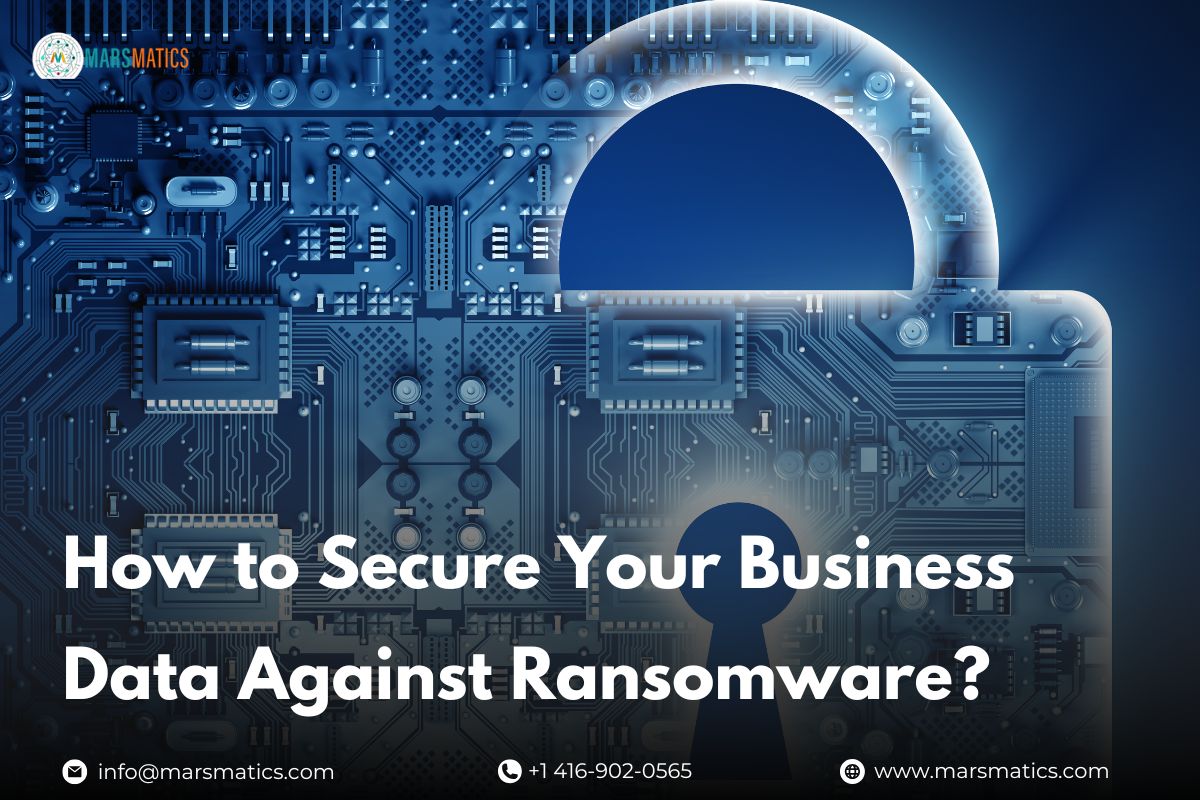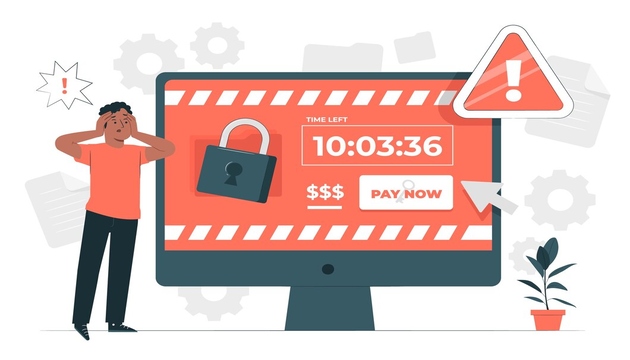How to Secure Your Business Data Against Ransomware?
Why do businesses often underestimate the threat of ransomware until it’s too late? A ransomware attack can lock you out of critical data, disrupt operations, and demand hefty payments, all while jeopardizing your reputation.
Therefore, understanding how to secure your business data against ransomware is vital to staying ahead of these threats. In this blog, we’ll explore ransomware prevention strategies, from employee training to implementing advanced cybersecurity tools, and discuss what steps to take if an attack occurs. Stay tuned to safeguard your business against this growing menace.
What is Ransomware?
Ransomware is a type of malicious software designed to block access to your data until you pay a ransom. Cybercriminals use it to target businesses and individuals, often by encrypting files and displaying a ransom note demanding payment.
Example
A small business owner opens an email attachment that looks like an invoice. Unknown to them, the attachment contains ransomware. Within minutes, all their important files, like customer records and financial data, are encrypted. A message appears on their screen, demanding payment in cryptocurrency to unlock the files. Even if they pay, there’s no guarantee the attackers will restore access. Ransomware is a growing threat, making it crucial to stay vigilant with cybersecurity practices like regular backups and employee training to avoid falling victim.
Signs Your Business Might Be a Target
| Sign | Explanation | How to Protect |
| Frequent Phishing Emails | You receive emails with suspicious links or attachments. | Educate employees on phishing scams as part of ransomware prevention. |
| Outdated Security Systems | Your software, firewalls, or antivirus programs haven’t been updated regularly. | Implement updates and patches as a core step in prevent ransomware best practices. |
| Unsecured Remote Access | Weak or shared passwords for remote access systems can be exploited. | Use multi-factor authentication (MFA) and restrict unnecessary remote access. |
| Unusual Network Activity | Unexplained spikes in data usage or slow network performance could indicate malicious activity. | Monitor networks closely and run regular scans to prevent ransomware attacks early. |
| Lack of Data Backups | If your critical data isn’t backed up, you’re more vulnerable to permanent data loss in an attack. | Schedule automated backups and store them in a secure, offline location. |
Recognizing these signs and implementing strategies to prevent ransomware attacks help your business can stay protected against emerging threats.
Best Practices to Secure Your Business Data
Employee Training:
To help employees become the first line of defense against ransomware attacks, it’s essential to focus on cybersecurity awareness. In 2024, phishing attacks are still a major entry point for cybercriminals, with over 20% of phishing emails containing links to ransomware.
A study by Proofpoint revealed that 88% of organizations worldwide experienced phishing attacks in 2022. This shows just how critical it is for organizations to prioritize employee education.
Training employees to recognize phishing attempts, avoid suspicious links, and report unusual activity can reduce the risk of these attacks significantly. For example, companies that implement regular phishing awareness training see a 60% reduction in successful phishing attempts. Additionally, simulated phishing exercises can help employees stay alert to evolving threats.
By focusing on these training programs, organizations can reduce the risk of ransomware, saving time and money while protecting sensitive information. In 2024, with the financial impact of phishing reaching an estimated $3.5 billion, these proactive steps are more crucial than ever.
Regular Data Backups:
Backing up your data frequently and securely is one of the most effective ways to recover from an attack. If ransomware encrypts your files, having an offline, untouched backup can save you from paying a ransom. According to Veritas Technologies, 47% of businesses affected by ransomware paid the ransom, but only 26% regained access to their full data. A solid backup strategy is essential to prevent ransomware attacks and minimize downtime. Ensure your backups are automated, encrypted, and stored in multiple locations, including offline systems.
Use Advanced Security Software:
Advanced security software is the backbone of a proactive approach to cybersecurity. Tools like endpoint detection, firewalls, and antivirus software help detect and block threats before they cause harm.
AI-powered software can identify suspicious patterns, preventing a potential attack in real-time. The ransomware attack definition involves exploiting vulnerabilities, and advanced tools can patch these gaps effectively. Gartner predicts that by 2025, 60% of organizations will use advanced AI-driven security systems as part of their prevent ransomware best practices.
By combining these practices, employee training, regular backups, and advanced security software, you can establish a robust strategy to prevent ransomware attacks and protect your business data.
Keep Systems Updated:
Regularly updating your business systems, software, and hardware is essential in preventing ransomware attacks. Cybercriminals often exploit vulnerabilities in outdated systems to gain unauthorized access. In fact, 60% of successful ransomware attacks occur because of known vulnerabilities that have not been patched.
By keeping your operating systems, antivirus software, and other critical applications up-to-date, you effectively reduce the attack surface for potential threats. This is a key aspect of ransomware prevention, ensuring that your systems are resilient against the latest attack techniques.
Implement Strong Access Controls:
Access controls are one of the most effective ways to prevent ransomware attacks. Limiting access to sensitive data based on roles and responsibilities reduces the number of potential entry points for cybercriminals. According to the ransomware attack definition, attackers often gain access through stolen credentials.
Therefore, implementing strong authentication mechanisms, such as multi-factor authentication (MFA), can significantly enhance security. In fact, organizations that utilize MFA see a 99.9% reduction in compromised accounts. Strong access controls are essential for preventing ransomware attacks by ensuring that only authorized personnel can access critical systems.

Engage a Cybersecurity Expert:
While in-house IT teams can manage basic security measures, engaging a dedicated cybersecurity expert offers specialized protection tailored to your business needs. Cybersecurity professionals are equipped to detect and respond to ransomware threats faster, providing real-time monitoring, vulnerability assessments, and incident response.
They can also help implement ransomware best practices that align with industry standards. According to experts, businesses that work with cybersecurity consultants experience a 40% decrease in the likelihood of a successful ransomware attack. For optimal ransomware prevention, having an expert on your team is a critical step in securing your business data against ransomware.
What to Do If You’re Attacked?
Here’s the information presented in a table format for better clarity:
| Step | Action | Reasoning/Notes |
| Isolate Infected Systems | Disconnect affected systems from the network. | Prevent the malware from spreading to other devices. |
| Report the Attack | Notify your IT team, external cybersecurity experts, and law enforcement. | Fast action helps contain the attack and get expert assistance. Reporting to agencies like CISA provides further guidance. |
| Don’t Pay the Ransom | Do not give in to the attackers’ demands for payment. | Paying does not guarantee recovery and may invite future attacks. Focus on data recovery through secure backups or expert assistance. |
| Restore from Backups | Use offline, secure backups to restore systems. | Ensure backups are untouched by the attack and are stored in a safe, disconnected location to avoid contamination. |
| Assess the Impact | Conduct a full forensic investigation of the attack. | Understand the scope of the attack, vulnerabilities exploited, and data affected, which will help in improving defenses for future threats. |
| Communicate with Stakeholders | Notify employees, customers, and partners about the attack and recovery process. | Transparent communication builds trust and assures stakeholders that recovery actions are being taken. |
By following these steps, your business can minimize the impact of a ransomware attack and recover as efficiently as possible. Each action ensures that the problem is contained, investigated, and mitigated effectively.
Benefits of Proactive Ransomware Prevention:
- Minimized Financial Losses
By proactively preventing ransomware attacks, businesses can avoid the significant costs associated with data loss, system downtime, and ransom payments. According to a report by Coveware, the average cost of a ransomware attack in 2024 is around $200,000
- Enhanced Business Continuity
Proactive ransomware prevention ensures that systems remain operational even in the event of a threat, reducing disruptions to business operations. Implementing prevent ransomware best practices, such as regular data backups and system updates, minimizes downtime during a crisis.
- Reduced Risk of Data Breaches
A strong ransomware prevention strategy reduces the likelihood of unauthorized access to sensitive information. By applying strict access controls and securing endpoints, businesses can lower the chance of data breaches and protect customer trust.
- Improved Reputation and Trust
Businesses that consistently practice ransomware prevention are viewed as more secure and trustworthy by customers and partners. Transparent communication about your cybersecurity practices further enhances this perception.
- Strengthened Employee Awareness
Regular employee training on identifying phishing attempts and securing sensitive data can significantly reduce human error, which is a major factor in many successful ransomware attacks. Employees who follow prevent ransomware attacks protocols are less likely to fall victim to scams.
- Regulatory Compliance
Many industries are subject to regulations requiring the protection of sensitive data (e.g., GDPR, HIPAA). Proactive ransomware prevention helps ensure compliance with these regulations, avoiding potential fines and legal liabilities.
- Faster Recovery Time
With robust prevention mechanisms in place, businesses can respond to ransomware attacks more swiftly, minimizing recovery time. A prepared business can restore data quickly from secure backups, following prevent ransomware best practices. - Cost-Effective Over Time
Investing in proactive ransomware prevention measures, such as security software, employee training, and regular updates, is more cost-effective than dealing with the aftermath of an attack. The upfront costs of prevention are far lower than the potential losses from a successful ransomware attack.
Conclusion:
Securing your business data against ransomware is no longer optional, it’s essential. By adopting proactive measures such as employee training, regular data backups, and advanced security software, you can significantly reduce the risk of falling victim to a ransomware attack.
It is important to understand the ransomware attack definition and following ransomware prevention strategies like keeping systems updated and implementing strong access controls will help prevent ransomware attacks. In the face of such threats, staying informed and prepared is key to maintaining business continuity and protecting sensitive data. Don’t wait until it’s too late take action now to safeguard your organization.
FAQS
What is ransomware, and how does it affect businesses?
Ransomware is a type of malicious software that encrypts a business’s files, demanding a ransom for their release. It can lead to significant financial losses, operational disruptions, and damage to a business’s reputation.
How can small businesses protect themselves from ransomware?
Small businesses can protect themselves by implementing strong security measures such as regular data backups, employee training on recognizing phishing emails, and using up-to-date security software.
Is paying the ransom the only way to recover data?
No, paying the ransom is not the only option. Businesses can restore data from secure backups or work with cybersecurity experts to decrypt files without paying the ransom.
What tools are recommended to protect against ransomware?
Recommended tools include advanced endpoint security software, backup solutions, multi-factor authentication (MFA), and network monitoring tools.









